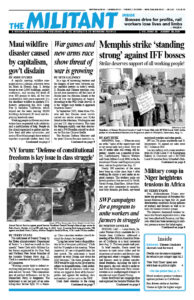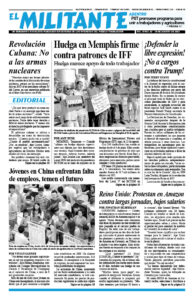A rapidly moving wildfire rampaged across Lahaina, a historic town on Maui in Hawaii Aug. 8, laying waste to over 2,000 buildings, mainly residences, and causing the death of over 100 people to date, all but two unidentified, with more expected. It is the deadliest wildfire in modern U.S. history, surpassing the 2018 Camp Fire in Paradise, California, which wiped out the town leaving 19,000 buildings destroyed, 85 dead and displacing hundreds more.
Working people in Hawaii and elsewhere have responded with solidarity and a mobilization of help. People on the island organized to gather and deliver food and other necessities, and across West Maui people have worked together to provide shelter, food, fuel and other resources to those who are now homeless.
Area unions like the United Public Workers mobilized their members to deliver aid. The International Longshore and Warehouse Union in Hawaii and on the mainland did likewise. If you want to help, contact the ILWU at www.ilwucu.org Kokua Maui Fund.
Residents who face rebuilding their lives from the ground up contrasted this outpouring of working-class solidarity with the seeming indifference of government authorities at all levels. Asked if he was warned about the fire, area resident Mike Stefl told the New York Times, “Oh, hell no.”
Local authorities never turned the area’s warning sirens on. The fires reached the town before any order to evacuate. Some tourists in hotels and residents in West Maui were instructed to shelter in place as the fire advanced.
Hawaiian Electric, which operates the electrical system in Maui, decided not to turn off the power despite gale-force winds that were knocking down power lines. There was a major power grid fault just after 11:38 p.m. Aug. 7, only 20 minutes before the first fire was reported. Downed lines are suspected to have been the immediate cause of the fires.
Firefighters who arrived to fight the rapidly spreading blazes discovered there was no water pressure in the town’s hydrants. The fire moved too fast to be fought with buckets.
There is only one road out of Lahaina and it was quickly clogged. Some fled on foot and were able to escape. Others waded into the ocean, staying there for hours. Others perished.
While the Camp Fire in Paradise burned 17 days, this fire reached the ocean and stopped within hours.
Working people in Paradise have sent their solidarity to the people of Maui. “Sending love and support from Paradise, California,” Melissa Crick sent to one woman there whose social media information she saw online. To her surprise, the woman wrote back, saying she knew about Paradise and the support meant a lot to her.
A disaster rooted in capitalism
The liberal press in the U.S. claims the problem in Maui was “how climate change turned lush Hawaii into a tinderbox,” as the New York Times put it. They blame high winds from a nearby hurricane, high temperatures and a drought for what happened.
But the truth is the profit-driven capitalist system is the culprit, as a look at the history of Hawaii and the allocation of resources in Maui today shows.
The Hawaiian Islands, a kingdom ruled by inhabitants from an earlier Polynesian migration, became an object of interest to U.S. capitalists in the 1800s. As sugar plantations began to dot the islands, their owners increasingly sought to take control. Led by Samuel Dole, sugar planters deposed the queen and seized power in 1893. In the context of the birth of U.S. imperialism in the Spanish-American War, Washington annexed Hawaii in 1898. It became a U.S. territory two years later, with Dole as its first governor.
As the 20th century dawned, pineapple plantations joined the sugar monopoly to dominate world production. Workers were drawn from China, Japan, Korea and the Philippines, and some from Latin America. Profits were amassed and mansions were built, many adorned with pampas grasses imported from South America.
Unions, led by the ILWU, battled to organize the workers, fighting for higher wages and better conditions in the sugarcane and pineapple fields.
The ILWU organized more than 26,000 sugar workers in an islands-wide strike in 1946, uniting workers from all nationalities. The victorious strike changed the balance of forces between workers and plantation bosses. “The politics of Hawaii would never be the same after that,” William Puette, director of the Center for Labor Education and Research at the University of Hawaii, wrote in 2017. “And certainly labor relations would not be the same.”
Over the next 50 years, the sugar and pineapple bosses lost markets to foreign competitors, and in 2016 the last sugar grower in Hawaii shut down. The flight of bosses seeking greater profits elsewhere is a story many workers are familiar with. Tourism and related industries now drive profits in Hawaii.
This meant thousands of acres of former plantations were left untended. The government there did nothing to protect the now nonproductive land, seeing no way to profit from it. “Those fire-prone invasive species fill in any gaps anywhere else — roadsides, in between communities, in between people’s homes, all over the place,” Elizabeth Pickett, co-executive director of the Hawaii Wildfire Management Organization told Wired.com Aug. 10. “At this point, 26% of our state is covered in these fire-prone grasses.” They were the tinder that exploded in flame in Maui.
This is a solvable problem. But the capitalist bosses and government at all levels in Hawaii didn’t take it on. And this, exacerbated by other electric company and government blunders during the fire, is what explains this was a social catastrophe rooted in the for-profit system, not “climate change.”

